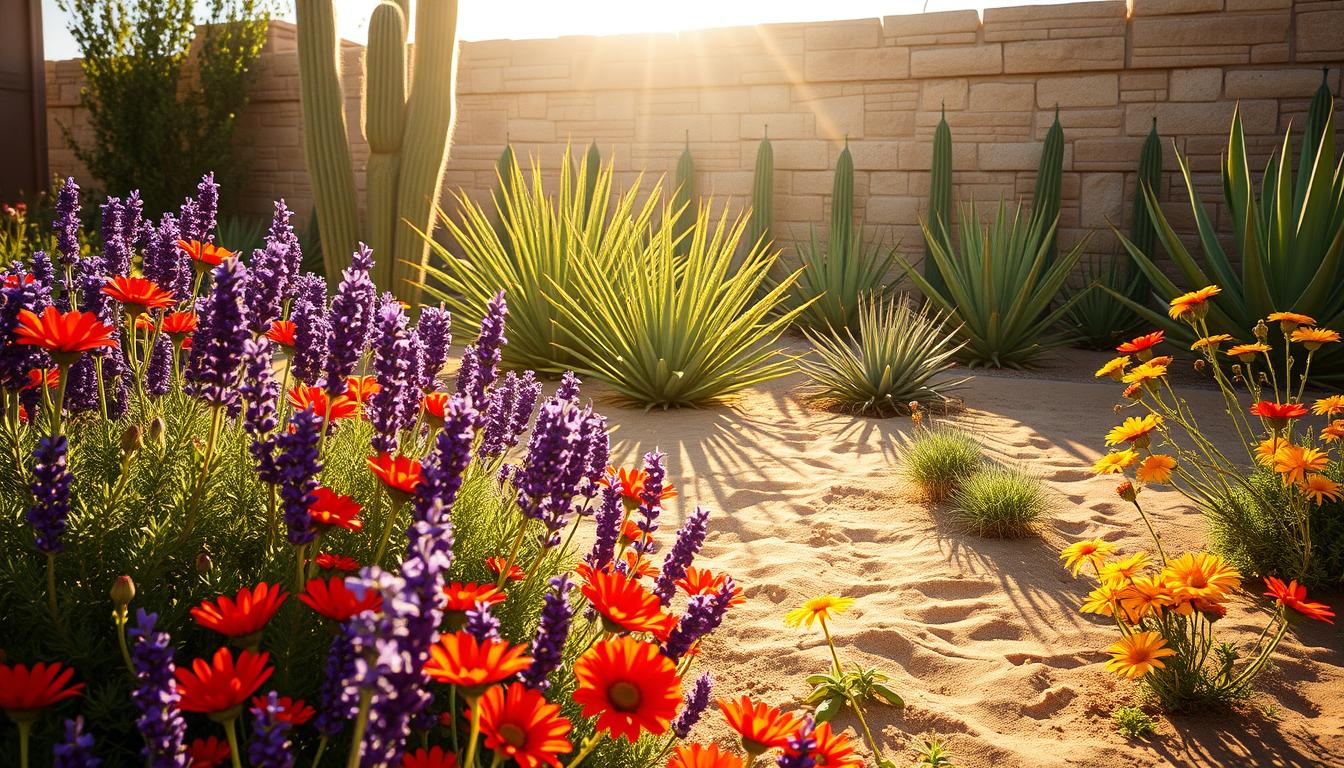Creating a beautiful garden that needs little water is key for today’s homeowners. With more dry spells across America, it’s smart to work with nature. This saves money and helps the planet.
Water-wise landscaping doesn’t mean giving up on beauty. Now, you can have stunning plants that need less water. These include colorful perennials, interesting succulents, and grasses that look great all year.
Many gardeners find that some plants thrive in dry conditions. These plants have special features like waxy leaves or deep roots. They help save water.
If you face water limits, live in a dry area, or want a green space that’s easy to care for, these plants are perfect. They turn your yard into a beautiful, low-maintenance spot. Plus, you’ll spend less time watering and more time enjoying your garden.
Why Water-Wise Gardening Matters
Water-wise gardening changes how we design our landscapes. It tackles environmental issues and meets homeowner needs. With water becoming more valuable in America, using drought-resistant plants is key. These gardens are not just beautiful but also help the environment.
Environmental Benefits of Reduced Water Usage
Conservation of Local Water Resources
Water-wise gardening helps save local water. In summer, watering can use up to 70% of home water. By using less water, you help keep community water supplies strong.
Reduced Runoff and Erosion
Water-wise gardens cut down on harmful runoff. This runoff often carries pollutants into waterways. The deep roots of these plants also stop soil erosion, keeping soil healthy and waterways clean.
Economic Advantages of Low-Maintenance Landscapes
Lower Water Bills
Water-wise gardens save money on water bills. Families can cut their water bills by 20-50%. This is a big savings, as water costs keep going up.
Reduced Maintenance Time and Costs
These gardens need less care than regular ones. You’ll spend less on mowing, fertilizing, and other upkeep. Plus, many drought-resistant plants don’t need much pruning and fight off pests and diseases naturally.
Understanding Drought-Tolerant Plants and Their Adaptations
Drought-tolerant plants are nature’s wonders. They have special ways to survive in very dry places. These plants have evolved over millions of years to live where others can’t.
Natural Mechanisms Plants Use to Survive Dry Conditions
These plants have clever ways to save water. They use these strategies to stay alive in dry times. This makes them great for gardens that need less water.
Specialized Leaf Structures
Many of these plants have leaves that help them keep water in. Lavender and sage have waxy leaves that reflect sunlight. They also have tiny hairs that keep moisture near the plant.
Succulents like sedums and aloes store water in their leaves. This acts like a water tank for them. Other plants reduce their leaves or shed them to lose less water.
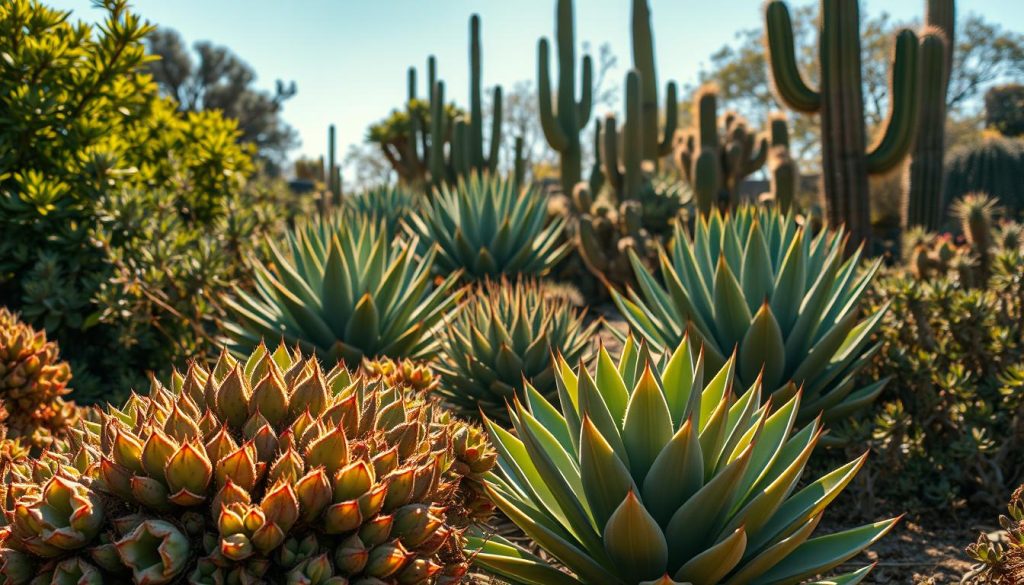
Underground, these plants also have amazing features. They have deep roots to find water deep in the soil. Plants like echinacea and rudbeckia can have roots up to 15 feet long.
Some plants have shallow roots to catch rain quickly. Others have special water-storing tissues in their roots. This creates an underground water tank.
How These Adaptations Benefit Your Garden
Knowing about these adaptations helps you choose the right plants. This makes your garden look great with less work.
Resilience During Water Restrictions
When there are water limits, regular plants may suffer. But drought-tolerant plants stay beautiful with little water. This keeps your garden looking good even when water is scarce.
Survival Through Seasonal Dry Periods
These plants can handle dry seasons on their own. They’re perfect for people who don’t have time to water often. This includes busy homeowners or those who are away for long periods.
By choosing plants with these traits, your garden stays beautiful and healthy. It needs much less care than regular gardens, even in dry times.
The Best Drought-Tolerant Plants for American Gardens
Building a drought-resistant landscape starts with choosing plants that thrive in your area. It’s not just about how much water they need. Other factors, like soil and climate, play a big role in their success.
Selection Criteria for Long-Term Success
To create a lasting drought-tolerant garden, look beyond water needs. Choose plants that naturally fit your local conditions. This way, they need little care once they’re settled.
Climate Compatibility Factors
Drought-tolerant plants don’t work the same everywhere. Weather, humidity, and rainfall affect how well they grow. What works in Arizona might not in Florida, even though both have dry spells.
Start with your USDA hardiness zone. But also think about your property’s microclimates. Places like south-facing slopes and areas near buildings have their own growing conditions.
Soil Type Considerations
Many drought-tolerant plants prefer certain soils. Some do well in poor, rocky soils but not in heavy clay. Check your soil’s texture, drainage, and pH before picking plants.
Sandy soils drain fast and need plants that can find water deep down. Clay soils hold water longer but can cause root rot in some plants. You might need to change your soil or pick plants that match it.
Top Performers Across Various Regions
While regions differ, some drought-tolerant plants do well everywhere.
Versatile Plants for Multiple Climate Zones
Some native plants adapt to many conditions. Black-eyed Susans (Rudbeckia hirta) bloom in zones 3-9 and need little extra water.
Butterfly weed (Asclepias tuberosa) supports pollinators and grows in poor soils and dry conditions across the US. Prairie dropseed grass (Sporobolus heterolepis) adds beauty to Midwestern gardens. California lilac (Ceanothus) shines in Western landscapes with its blue flowers.
Award-Winning Varieties for Reliability
For reliable choices, look at plants recognized by horticultural groups. ‘Powis Castle’ Artemisia is known for its drought tolerance and silvery leaves.
‘May Night’ Salvia, named Perennial Plant of the Year, blooms deep purple with little water. These plants show they can look great even in tough weather.
Stunning Succulents for Water-Scarce Gardens
Turn your dry landscape into a stunning oasis with succulents. These plants are great at saving water. They store moisture in their tissues, helping them survive when it’s dry.
Succulents come in many shapes and sizes. They can be small or very tall. This makes them perfect for gardens that don’t get much water.
Architectural Aloes and Agaves
Aloes and agaves are great for adding drama to your garden. They have unique shapes and stand out with their silhouettes.
Aloe vera, Agave americana, and Agave parryi
Aloe vera is not just good for you. It also has beautiful flowers that hummingbirds love. This makes your garden more interesting for wildlife.
Agave americana is huge and eye-catching. Its leaves can grow up to 6 feet wide. Agave parryi is smaller but still beautiful, with leaves that are blue-gray and have a burgundy edge.
When you put these plants in your garden, make sure to space them right. Give them 1.5 to 2 times their mature width. This lets you see their unique shapes. Place them where they can be seen, like against walls or in gravel gardens.
Colorful Sedums and Echeverias
Sedums and echeverias add color and softness to your garden. They are good at handling dry conditions but look delicate.
Sedum ‘Autumn Joy’, Echeveria elegans, and Sedum spurium
Sedum ‘Autumn Joy’ changes color with the seasons. It starts green, turns pink, and then russet in the fall. It’s beautiful and doesn’t need much water.
Echeveria elegans has beautiful blue rosettes. They are small but catch the light beautifully. They add elegance to your garden.
Sedum spurium spreads and has red leaves. It’s good for covering the ground. It grows well in poor soil and needs very little water.
Creating Succulent Arrangements
Put different succulents in containers for a mobile garden display. Mix plants with different colors and textures. Put taller ones in the middle and trailing ones at the edges. Use soil that drains well and containers with holes to avoid root rot.
Unique Cacti Varieties for Ornamental Appeal
Cacti are perfect for dry gardens. They have unique shapes and can bloom in the driest conditions.
Opuntia, Echinocereus, and Ferocactus Species
Opuntia cacti have paddle-shaped pads and bright flowers in spring. They also have edible fruits, making your garden useful.
Echinocereus cacti are small but have beautiful flowers in spring. Their colorful spines add interest all year, even when they’re not blooming.
Ferocactus cacti are tall and have a unique shape. They are great for adding height to your garden.
Safety Considerations for Families and Pets
Be careful with cacti in family gardens. Keep them away from places where people and pets play. Some cacti are spineless, making them safer for everyone.
| Succulent Type | Water Needs | Sun Exposure | Height Range | Special Features |
|---|---|---|---|---|
| Aloes | Low (every 3-4 weeks) | Full to partial sun | 1-3 feet | Medicinal properties, winter/spring blooms |
| Agaves | Very low (monthly) | Full sun | 1-6 feet | Architectural form, century-long lifespan |
| Sedums | Low (every 2-3 weeks) | Full to partial sun | 3-24 inches | Seasonal color changes, pollinator attraction |
| Echeverias | Low (every 2 weeks) | Bright, indirect light | 3-12 inches | Rosette formation, frost-sensitive |
| Cacti | Extremely low (monthly) | Full sun | 6 inches to 10+ feet | Dramatic flowers, extreme drought tolerance |
Perennial Powerhouses That Beat the Heat
Hardy perennials are key to sustainable, low-maintenance gardens. They can handle intense heat and drought. These plants come back stronger every year, needing less water.
Their roots get better at finding water as the seasons go by. This makes them very efficient.
Lavender, Sage, and Other Mediterranean Favorites
Mediterranean herbs are perfect for hot, dry places like many parts of America. Their silver-gray leaves and fragrant oils help them save water. They do well in tough environments.
Lavandula angustifolia, Salvia officinalis, and Rosmarinus officinalis
English lavender has beautiful purple flowers and silvery leaves. It grows well in poor soil. Culinary sage has gray-green leaves and purple flowers that bees love.
Rosemary has woody stems and fragrant leaves. It needs little water and loves sunny spots.
Culinary and Aromatic Benefits
These plants are not just pretty. They’re also useful in cooking and for making remedies. Their long blooming seasons help pollinators all season.
Native Prairie Plants with Deep Root Systems
America’s native prairie plants are very good at surviving dry conditions. They have deep roots to find water deep underground.
Echinacea purpurea, Rudbeckia hirta, and Asclepias tuberosa
Purple coneflower attracts butterflies and has deep roots. Black-eyed Susan blooms for months with little water. It brightens gardens from summer to fall.
Butterfly weed has orange flowers and supports monarch butterflies. Its deep root helps it survive dry spells.
Wildlife Benefits and Ecosystem Support
These plants are important for local wildlife. They provide food and shelter. By using them, gardeners help support biodiversity.
Ornamental Grasses That Thrive in Dry Conditions
Drought-tolerant ornamental grasses add beauty to gardens with little water. They have different textures and shapes for every season.
Muhlenbergia capillaris, Schizachyrium scoparium, and Bouteloua gracilis
Pink muhly grass has stunning rosy plumes in fall. Little bluestem changes color from green to orange-red in fall. Blue grama grass has seed heads that look like eyelashes.
All three grasses need little water once they’re established.
Seasonal Interest and Movement
These grasses are interesting in winter when other plants are gone. Their seed heads and dried leaves move with the wind. This adds a lively feel to gardens.
Drought-Resistant Shrubs for Structure and Privacy
Drought-resistant shrubs save water and add beauty to gardens. They create boundaries and focal points with little water. Once grown, they need little care, fitting well into low-maintenance gardens.
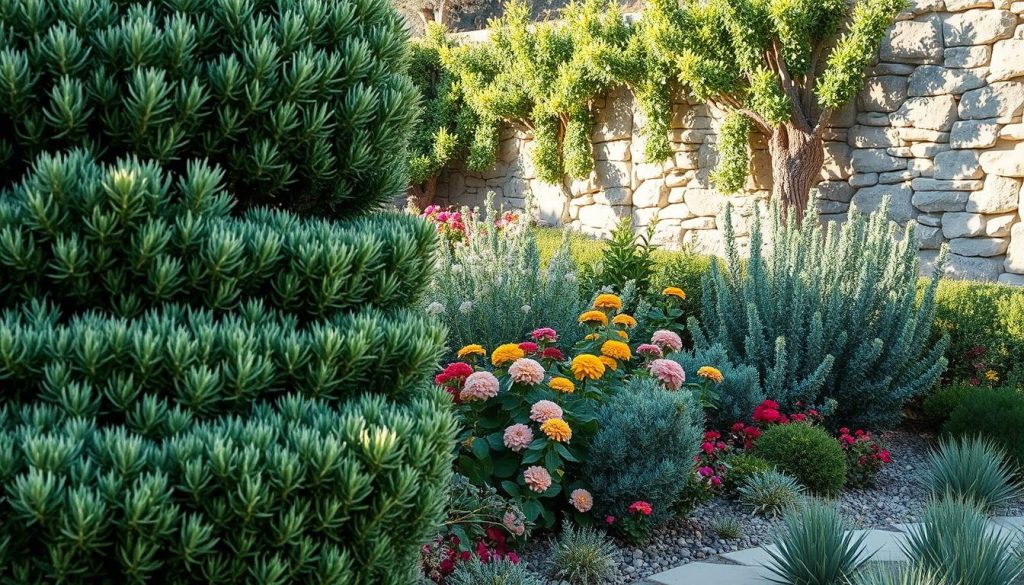
Flowering Options Like Butterfly Bush and Russian Sage
Flowering shrubs are beautiful and practical. They attract pollinators and handle tough conditions better than regular plants.
Buddleja davidii, Perovskia atriplicifolia, and Caryopteris × clandonensis
Butterfly bush has sweet-scented flowers that attract butterflies and hummingbirds. It grows fast, reaching 5-10 feet tall, and loves sunny spots.
Russian sage has lavender-blue flowers and silvery leaves. It tolerates poor soil and heat, blooming from midsummer to fall.
Bluebeard blooms with vibrant blue flowers late in the season. It’s small, making it great for tight spaces or the front of borders.
Pruning for Maximum Bloom
Pruning helps drought-resistant shrubs bloom more. Butterfly bush does best with a hard prune in early spring. This encourages new growth and bigger flowers.
Russian sage needs little care. Just remove dead stems in spring and trim for shape. Bluebeard blooms on new wood, so prune it back in spring for more flowers and a neat shape.
Evergreen Choices for Year-Round Interest
Evergreen shrubs offer year-round beauty. They keep their leaves in winter when other plants are bare.
Juniperus horizontalis, Mahonia aquifolium, and Arctostaphylos uva-ursi
Creeping juniper is great for slopes and hard spots. It spreads and prevents erosion with little care.
Oregon grape has glossy leaves and yellow flowers in spring. It grows 3-6 feet tall and does well in sun or shade.
Kinnikinnick is a groundcover with white flowers and red berries. It spreads slowly, suppressing weeds and protecting soil.
Strategic Placement in the Landscape
Place drought-resistant shrubs wisely in your garden. Use tall ones like butterfly bush and Oregon grape as screens. Medium-sized shrubs like Russian sage and bluebeard work well in borders.
For slopes or poor soil, use spreading types like creeping juniper and kinnikinnick. Make sure they get at least 6 hours of sun a day.
| Shrub Type | Height/Width | Bloom Time | Special Features | Best Uses |
|---|---|---|---|---|
| Butterfly Bush | 5-10 ft / 4-8 ft | Summer-Fall | Attracts pollinators | Privacy screens, focal points |
| Russian Sage | 3-4 ft / 3-4 ft | Midsummer-Fall | Silver foliage, drought-tolerant | Borders, mass plantings |
| Bluebeard | 2-4 ft / 2-4 ft | Late Summer-Fall | Blue flowers, compact size | Small spaces, front of borders |
| Oregon Grape | 3-6 ft / 3-5 ft | Spring | Evergreen, berries | Shade gardens, hedges |
| Creeping Juniper | 1 ft / 6-8 ft spread | Non-flowering | Erosion control, evergreen | Slopes, groundcover |
Water-Wise Trees That Provide Shade and Beauty
The right drought-tolerant trees act as living umbrellas, offering essential shade for your garden. These trees help reduce water needs by cooling the soil and creating microclimates. Adding trees to your garden brings many benefits:
- Reduced water evaporation from soil
- Lower cooling costs for nearby structures
- Habitat for beneficial wildlife
- Increased property value
- Visual anchors for landscape design
Deciduous Options for Seasonal Interest
Deciduous trees provide cooling shade in summer and let sunlight in during winter. This is great for saving energy.
Cercis canadensis, Pistacia chinensis, and Gleditsia triacanthos
Eastern redbud (Cercis canadensis) blooms with vibrant pink flowers in spring. It grows well in different soils and reaches 20-30 feet tall.
Chinese pistache (Pistacia chinensis) is known for its drought tolerance and fall color. Its leaves turn orange-red in autumn, adding a fiery touch to your garden.
Honeylocust (Gleditsia triacanthos), like ‘Shademaster,’ offers filtered light. It’s perfect for growing plants underneath while providing heat relief.
Fall Color and Ornamental Features
These deciduous trees add interest beyond summer. Eastern redbud’s leaves turn golden yellow in fall, and its seed pods add winter texture. Chinese pistache provides reliable fall color, even in hot climates.
Evergreen Selections for Constant Structure
Evergreen trees provide year-round screening and landscape structure.
Pinus edulis, Cupressus arizonica, and Quercus virginiana
Pinyon pine (Pinus edulis) has blue-green needles and a rounded shape. It grows slowly, producing edible pine nuts, and thrives in poor soils.
Arizona cypress (Cupressus arizonica) has striking blue-silver foliage and tolerates heat well. Its dense growth is great for windbreaks.
Southern live oak (Quercus virginiana) grows into a magnificent tree with drought tolerance. Its broad canopy creates significant shade zones.
Long-Term Growth Expectations
Consider the mature sizes of these trees. Pinyon pine grows to 20-30 feet. Arizona cypress reaches 40-50 feet. Live oaks can spread over 60 feet wide over decades.
Place these trees carefully to enhance your property and contribute to conservation. They provide shade and windbreaks.
Xeriscaping Principles for Maximum Water Efficiency
Xeriscaping helps homeowners save water while keeping their outdoor spaces lively and easy to care for. This method can cut down water use by 50-75%. It does this through smart design, choosing the right plants, and using water wisely.
Designing with Drought in Mind
Starting with a good plan is key to xeriscaping. Think about your local weather, soil, and how you use your yard. This planning is the first step to saving water.
Hydrozoning Strategies
Hydrozoning groups plants by their water needs. This stops overwatering plants that don’t need it. Place plants needing lots of water near your home. Then, move to plants that need less water as you go further out.
Hardscape Integration
Hardscaping makes your yard look good and saves water. Use materials like gravel or stepping stones that let water soak in. Features like boulders and patios need no water.
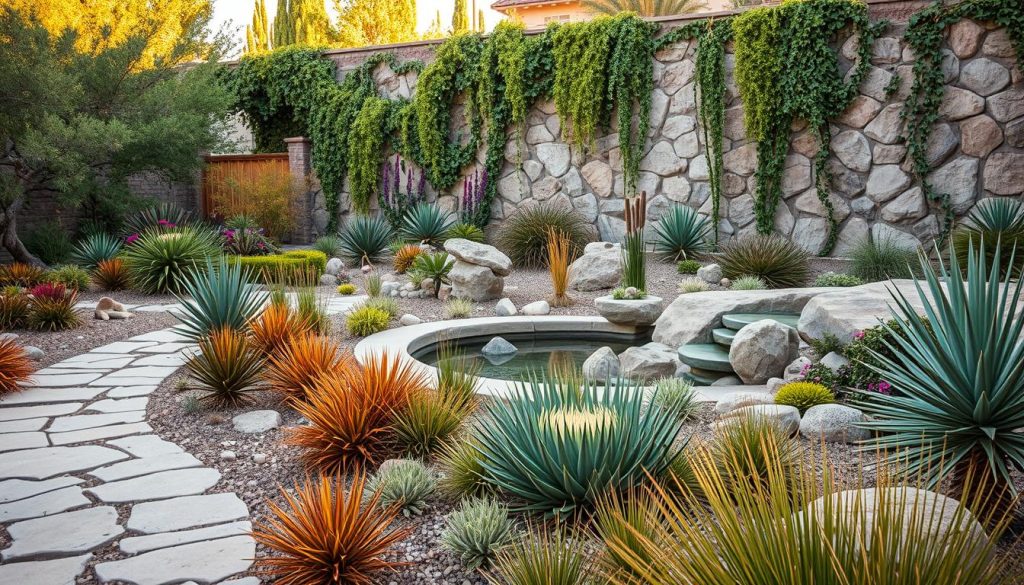
Soil Preparation and Mulching Techniques
Good soil is the base of xeriscaping. It helps plants grow strong roots. Mulch also helps by keeping water in and weeds out.
Organic vs. Inorganic Mulch Options
Both organic and inorganic mulches are good for saving water. Choose based on your climate and what you like.
| Mulch Type | Water Retention | Longevity | Soil Benefits | Best Applications |
|---|---|---|---|---|
| Shredded Bark | Excellent | 1-3 years | Improves soil structure as it decomposes | Around trees, shrubs, perennials |
| Compost | Very Good | 6-12 months | Adds nutrients and beneficial microbes | Vegetable gardens, annual beds |
| Decorative Gravel | Moderate | Permanent | Minimal; may heat soil in hot climates | Desert gardens, pathways, around succulents |
| River Rock | Low | Permanent | None; creates heat reflection | Drainage areas, accent features |
Soil Amendment Recommendations
For most plants, avoid too many amendments. In clay soils, add compost to help water drain. Sandy soils need organic matter to hold water. Mycorrhizal fungi can help plants reach deeper water.
Efficient Irrigation Systems
Even water-saving gardens sometimes need extra water, like when they’re new. Modern irrigation systems deliver water just where it’s needed, saving a lot.
Drip Irrigation Setup
Drip irrigation cuts water use by 30-50%. It avoids waste by not spraying water everywhere. Use emitters that give the same flow at any height. Place drip lines at plant roots and cover with mulch.
Smart Controllers and Sensors
Weather-based controllers can make your irrigation even smarter. They adjust watering based on weather. Soil sensors and rain sensors save water by stopping irrigation when it’s not needed. Many places offer rebates for these, making them a smart choice for saving water.
Regional Guide to Drought-Tolerant Plants Across the United States
Every part of the United States has its own special needs for plants. From the dry deserts to the wet coasts, what grows well in Arizona might not make it in Maine. So, picking the right plants for your area is key.
Southwest Desert Landscapes
The Southwest is tough for gardeners, with very hot temperatures and little rain. But, it’s also home to amazing plants that have learned to survive in these harsh conditions.
Arizona, New Mexico, and Nevada Natives
Desert marigold (Baileya multiradiata) is a bright yellow flower that needs almost no water. Penstemon species have vibrant flowers that attract hummingbirds and can survive on rain alone. Apache plume (Fallugia paradoxa) has white flowers all year, followed by pink seed heads.
Desert-Adapted Imported Species
Trailing lantana (Lantana montevidensis) is a colorful ground cover that can handle over 110°F. Texas ranger (Leucophyllum frutescens) grows well in the Southwest, with silver leaves and purple flowers after it gets humid.
California and Pacific Northwest Options
These areas have a Mediterranean climate, with rain in winter and dry summers. This makes them perfect for a wide range of drought-resistant plants.
Mediterranean Climate Selections
California lilac (Ceanothus) has amazing blue flowers and helps local bees. Manzanita (Arctostaphylos) has red bark and flowers all year. Pacific Coast iris blooms in spring and rests during the dry months.
Coastal gardens can have softer plants like rockrose (Cistus) and California poppy (Eschscholzia californica). But, inland areas with big temperature swings need tougher plants like deer grass (Muhlenbergia rigens) and toyon (Heteromeles arbutifolia), which can handle frost and heat.
Midwest and Great Plains Selections
These areas face drought and cold winters, making plant choice very important. Native prairie plants are both beautiful and tough.
Prairie Restoration Plants
Little bluestem (Schizachyrium scoparium) turns blue-green in summer and russet in fall. Prairie dropseed (Sporobolus heterolepis) has fine foliage and delicate seed heads. Compass plant (Silphium laciniatum) sends deep roots to find water during dry times.
Urban Garden Solutions
Compact natives like prairie smoke (Geum triflorum) have charming spring flowers and feathery seed heads. Aromatic aster (Symphyotrichum oblongifolium) blooms in late summer in small spaces and handles drought and poor soil.
Southeast and East Coast Choices
These regions have drought, heavy rain, and high humidity. The right plants can handle these changes with little extra water.
Heat and Humidity Tolerant Varieties
Oakleaf hydrangea (Hydrangea quercifolia) is interesting all year with less water than others. Yaupon holly (Ilex vomitoria) is evergreen and has berries for birds. Pink muhly grass (Muhlenbergia capillaris) has stunning pink plumes in fall.
Salt-Tolerant Coastal Options
Seaside goldenrod (Solidago sempervirens) brightens fall with its yellow flowers and can handle salt spray. Beach plum (Prunus maritima) has spring flowers, summer fruit, and is very drought-tolerant. American beautyberry (Callicarpa americana) has purple berries and helps stabilize coastal soils and support wildlife.
Creating a Low-Water Garden That Still Pops with Color
Many think water-efficient gardens are dull. But with the right planning and plants, they can be vibrant and beautiful. These gardens are not only good for the environment but also stunning.
Seasonal Planning for Continuous Blooms
To keep your garden interesting all year, choose plants that bloom at different times. This way, your garden will always have something beautiful to show.
Spring to Summer Transition Plants
Begin with drought-tolerant spring bulbs like tulips and bearded iris. They bloom early and need little water.
As summer comes, switch to plants like yarrow and catmint. Later, use drought-resistant flowers like blanket flower and Russian sage to keep your garden lively.
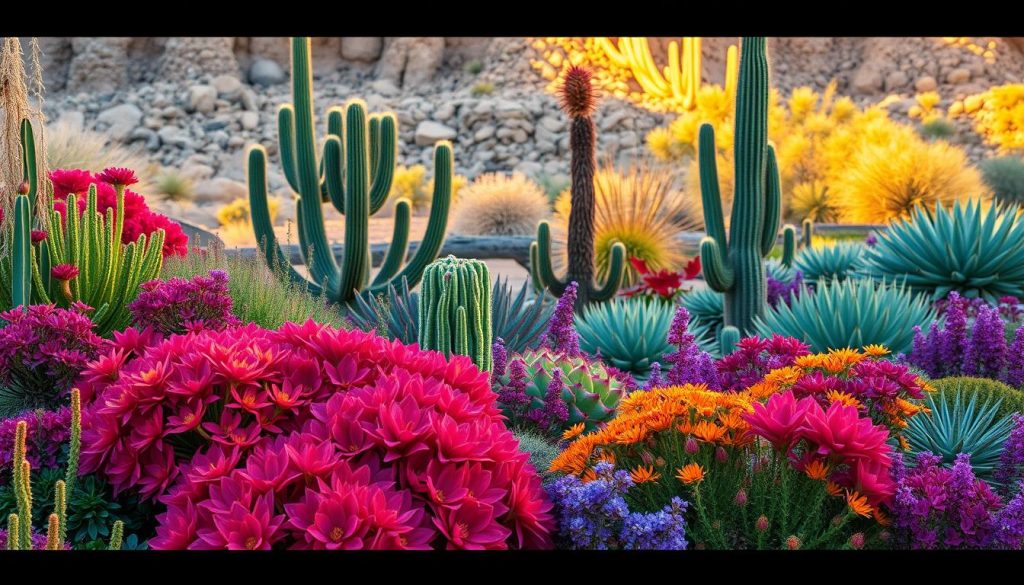
In autumn, add ornamental grasses and sedums like ‘Autumn Joy’ for color. Compact junipers and manzanitas provide green all winter, looking great with frost or snow.
Color Combinations That Work in Arid Settings
Water-wise gardens can have beautiful color schemes. Choose plants with bright blooms or interesting leaves.
Silver and Blue Palettes
For a cool look, mix silvery plants like artemisia with blue flowers. Add succulents or grasses for a refreshing feel, even in the heat.
Sunset-Inspired Warm Tones
Warm colors can make a big statement. Use orange poppies, crimson penstemons, and golden yarrows for a striking look. These colors shine when the sun hits them, making your garden glow.
Maintaining Your Drought-Tolerant Landscape
Drought-resistant landscapes are beautiful and save water. They need less care than regular gardens. Knowing how to care for them ensures they thrive for years.
Establishment Period Care
The first year is key for your water-wise garden’s success. Even drought-hardy plants need help getting started.
First-Year Watering Schedule
During the first year, plants need regular watering. Start with deep watering twice a week for a month. Then, water once a week for the rest of the growing season. Adjust for rain and temperature changes.
Root Development Support
Help plants grow deep roots by using 2-3 inches of mulch. Avoid high-nitrogen fertilizers. They promote leaf growth over root growth. Your goal is to help plants find water deep in the soil.
Seasonal Maintenance Tips
Once plants are established, they need little care. But, seasonal attention helps them perform their best.
Spring Preparation Tasks
- Remove winter-damaged stems and branches
- Replenish mulch where needed
- Apply slow-release, low-nitrogen fertilizer only if soil tests indicate deficiencies
- Divide overcrowded perennials before new growth accelerates
Fall and Winter Protection
Leave ornamental grasses and seedheads intact through winter. They add interest and protect plants from cold. In cold areas, wrap new shrubs with burlap to protect them from wind.
Pruning and Division Schedules
Pruning keeps plants healthy and encourages blooming in your water-wise garden.
Deadheading for Extended Blooms
Removing spent blooms from plants like lavender and catmint encourages more flowers. This simple step prevents seed formation and extends the blooming season.
Rejuvenation Techniques for Aging Plants
As plants like lavender and sage get older, they may become woody. Cutting them back by one-third every few years helps. For ornamental grasses, cut them to 4-6 inches before they grow again to keep them looking good.
With these maintenance tips, your drought-resistant landscape will grow more beautiful and resilient. It will stay low-maintenance with age.
The Future of Water-Wise Landscaping in a Changing Climate
Climate patterns in the United States are changing, making water-wise gardening essential. Many areas now face longer dry spells, even in places that used to have plenty of water.
Cities are starting to offer rebates for xeriscaping projects. They’re also introducing new landscaping codes that limit traditional lawns. This shift highlights the chance to save water without losing the beauty of outdoor spaces.
The plant nursery industry is growing its selection of drought-tolerant plants. Scientists are working on new varieties that are both water-efficient and visually appealing.
These landscapes offer more than just water savings. They also mean less chemical use, better habitats for wildlife, and more resilience to extreme weather. Drought-resistant gardens use fewer resources but still add color, texture, and interest all year.
As we deal with climate changes, adopting water-wise landscaping is key. It helps create gardens that are not only beautiful but also sustainable. The future of gardening in America is about working with nature, making landscapes that can thrive in tough conditions.

